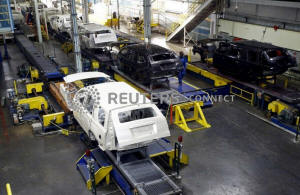Strong U.S. job growth showcases economy's resilience
 Send a link to a friend
Send a link to a friend
 [December 07, 2019] By
Lucia Mutikani [December 07, 2019] By
Lucia Mutikani
WASHINGTON (Reuters) - U.S. job growth
increased by the most in 10 months in November as the healthcare
industry boosted hiring and production workers at General Motors <GM.N>
returned to work after a strike, the strongest sign yet the economy is
in no danger of stalling.
The unemployment rate ticked back down to its lowest level in nearly
half a century and wage gains remained near their strongest in a decade,
the Labor Department's closely watched monthly employment report showed
on Friday.
The numbers suggest consumers will keep the longest economic expansion
in history, now in its 11th year, chugging along into next year when
Americans will decide whether to re-elect President Donald Trump.
The report added to other fairly upbeat data on the trade deficit,
housing and orders for big-ticket goods. Together, the improving data
appear to validate the Federal Reserve's decision in October to signal
no further interest rate cuts are needed for now. The U.S. central bank
cut rates three times this year, starting in July when it reduced
borrowing costs for the first time since 2008.

U.S. central bank policymakers are expected to highlight the economy's
resilience when they meet on Dec. 10-11, though trade tensions continue
to reverberate in the background.
"This was a strong report, with a solid rise in payrolls, another drop
in the unemployment rate, and decent growth in hourly earnings," said
Chris Low, chief economist at FHN Financial in New York. "The Fed will
see this as clear vindication of their decision to stop cutting rates."
Nonfarm payrolls increased by 266,000 jobs last month, lifted by the
gain of 60,200 healthcare workers, the most since March, and increased
hiring at restaurants and bars, the government's survey of
establishments showed. Manufacturing recouped all the 43,000 positions
lost in October.
But colder-than-normal temperatures in November curbed hiring at
construction sites and helped to sink mining payrolls.
The largest increase in payrolls since January pushed job growth well
above its monthly average of 180,000 this year. Economists polled by
Reuters had forecast payrolls rising by 180,000 jobs in November. The
economy created 41,000 more jobs in September and October than
previously estimated.
Even discounting the roughly 46,000 GM returnees, employment growth
exceeded 200,000 jobs last month. The robust payroll gains suggest the
Trump administration's 17-month trade war with China, which has plunged
manufacturing into recession, has not yet spilled over to the broader
economy.
Some economists said this could buy the Trump administration more time
as it negotiates a "phase one" trade deal with China. Top White House
economic adviser Larry Kudlow said on Friday the Dec. 15 deadline
remained in place for a new round of U.S. tariffs on Chinese goods set
to kick in, adding "there's no arbitrary deadline," on trade talks.

"The report alleviates pressure on the Trump administration to make a
trade deal with China, giving negotiators more leverage to push for a
harder line," said Daniel Zhao, a senior economist at Glassdoor in San
Francisco.
The dollar <.DXY> strengthened against a basket of currencies, snapping
a five-day losing streak. U.S. Treasury prices fell. Stocks on Wall
Street rallied after a roller-coaster week.
[to top of second column] |

SUVs move through the assembly line at the General Motors Assembly
Plant in Arlington, Texas June 9, 2015. REUTERS/Mike Stone

STEADY WAGE GAINS
The U.S.-China trade spat has bruised business confidence and undercut capital
expenditure, tipping manufacturing into recession. The magnitude of last month's
increase in payrolls is at odds with other labor market data.
Job openings are near a 1-1/2-year low, small business hiring intentions have
softened relative to 2018 and the Institute for Supply Management survey's
measure of factory employment has contracted for four straight months.
"While this morning's reading is a definite improvement, it does little to
explain waning momentum over the past ten months," said Lindsey Piegza, chief
economist at Stifel in Chicago. "It remains to be seen if such strength signals
a turning point to more robust hiring patterns."
Though the labor market remains resilient despite the business investment
downturn, hiring has slowed from last year's average monthly gain of 223,000
because of ebbing demand and a shortage of workers. The government has said it
could cut job growth for the 12 months through March 2019 by at least 500,000
jobs when it publishes its annual revision next February.
Still, job creation is well over the roughly 100,000 jobs per month needed to
keep up with growth in the working-age population. The unemployment rate fell
one-tenth of a percentage point to 3.5% percent, matching September's reading,
which was the lowest level since December 1969.
A broader measure of unemployment, which includes people who want to work but
have given up searching and those working part-time because they cannot find
full-time employment, fell to 6.9% from 7.0% in October. The labor force
participation rate, or the proportion of working-age Americans who have a job or
are looking for one, dipped to 63.2% in November from more than a six-year high
of 63.3% in October.
Average hourly earnings rose seven cents, or 0.2%, after increasing 0.4% in
October. In the 12 months through November, wages rose 3.1% after advancing 3.2%
in October. Wages were held back by the concentration of hiring in low-paying
industries.

Average hourly earnings for production and non-supervisory workers, considered a
more reliable wage measure, increased 0.3% and were up 3.7% on a year-on-year
basis in November.
"That should keep consumer spending in good shape in the coming months," said
Sarah House, a senior economist at Wells Fargo Securities in Charlotte, North
Carolina.
Manufacturing employment rebounded by 54,000 jobs in November. Construction
hiring rose by only 1,000 jobs, while mining shed 7,000 jobs.
The leisure and hospitality industry hired 45,000 workers. It has added 219,000
jobs over the last four months, with about two-thirds of the gains at
restaurants and bars.
There were also increases in professional and business services, financial
activities, and transportation and warehousing jobs last month. Government
employment increased by 12,000 jobs.
(Editing by Alistair Bell and Paul Simao)
[© 2019 Thomson Reuters. All rights
reserved.] Copyright 2019 Reuters. All rights reserved. This material may not be published,
broadcast, rewritten or redistributed.
Thompson Reuters is solely responsible for this content. |